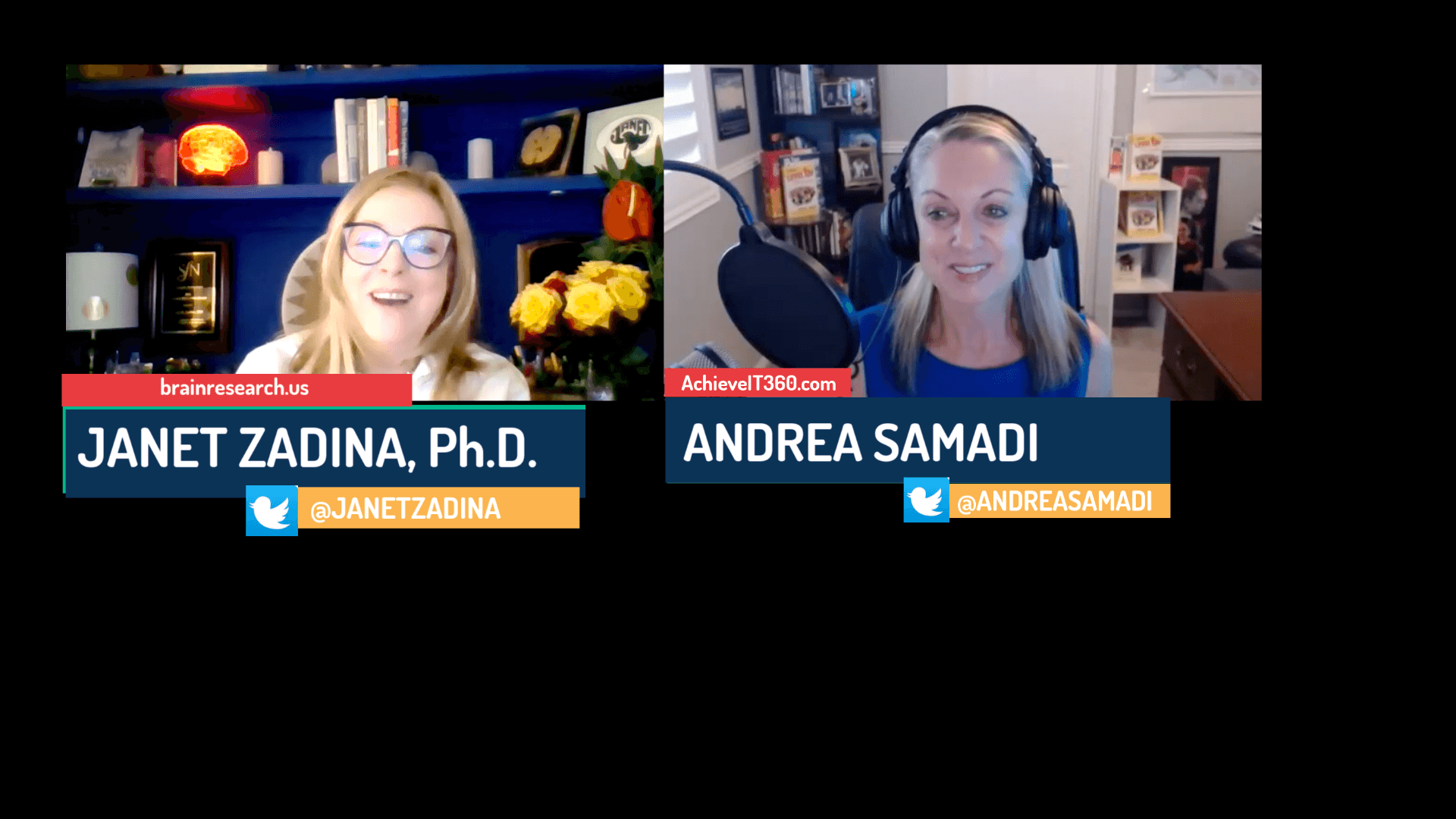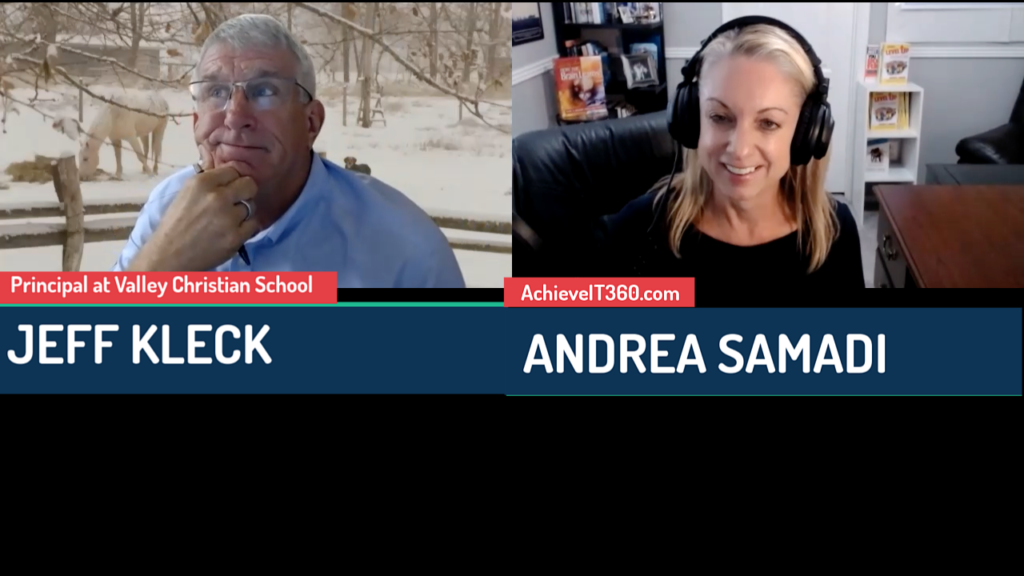For today’s EPISODE #280, we will be speaking with a pioneer in the field of educational neuroscience. The book she wrote, Multiple Pathways to the Student Brain covers the years of work she spent speaking to teachers all over the world about how the brain learns and what this means in the classroom. At the time she graduated, she was the ONLY person, so far as she knew, using the term educational neuroscience.
Watch this interview on YouTube here https://youtu.be/mU6eGZi6Rng

On today’s Episode #280 we will cover
✔ How Andrea was referred to study Janet Zadina's work back in 2014.
✔ The Impact of Dr. Zadina's Significant Contribution in Academics and Education Over the Years.
✔Janet Zadina's Arduous Pathway Bridging Education and the Brain since the 1980s.
✔ How Dr. Zadina Saw How Neuroimaging Could Help Change the Way We Teach Our Future Generations.
✔ Janet Zadina's Thoughts on Where Educational Neuroscience Began, and Where It's Going.
✔ Tools and Resources for Educators on her website www.brainresearch.us
Welcome back to The Neuroscience Meets Social and Emotional Learning Podcast, where we cover the science-based evidence behind social and emotional learning (for schools) and emotional intelligence training (in the workplace) with tools, ideas and strategies that we can all use for immediate results, with our brain in mind. I’m Andrea Samadi, an author, and educator with a passion for learning specifically on the topics of health, wellbeing and productivity, and launched this podcast to share how important an understanding of our brain is to our everyday life and results, using the most current brain research. If there’s a tool, strategy or resource that I find, that could be helpful to improve productivity and results, whether we are a teacher in the classroom, a coach or in the modern workplace, I will share it here.
On today’s episode #280 we will be speaking with someone I was referred to back in 2014, from Jeff Kleck, from EP #246[i]. He was the educator who handed me a bunch of books off his book shelf and urged me to move in the direction of educational neuroscience, to make a bigger impact with my work. He didn’t give me our next guest’s book, (so I figured it must be important to him) but he told me to write down “Dr. Janet Zadina[ii]” and study her.
Now, I don’t ignore anything someone tells me to do, especially if there is learning involved, so I wrote down Dr. Zadina’s name, and immediately followed her work back in 2014. I had no idea at the time that Dr. Zadina was one of THE leaders, spearheading educational neuroscience in the country, before it was even called this, and now fast forward to last September, when Jeff Kleck and I finished our interview, he asked me “Did you ever interview Dr. Janet Zadina?” I just looked at him thinking “How did I miss that?” remembering it was important.
I remembered standing in his office, holding a bunch of books he asked me to read, and then we went to his computer and he pulled up all the FREE resources and most up to date research on Janet Zadina’s website[iii] that he told me to review. It was Dr. Zadina’s work that helped me to begin in this field of educational neuroscience, making the connections to the brain and learning. Today’s guest, Dr. Janet Zadina, we will soon discover, a former high school and college teacher and cognitive neuroscientist whose background, expertise, energy, and humor all took her to international acclaim.
Before we meet Dr. Zadina, I want to share a bit about how she is changing lives with science and strategies.
She’s been said to be "Powerful!" "Engaging!" "Innovative!" "Life Changing!" These are just a few of the words audiences use to describe concepts and presentations by Janet Zadina, Ph.D. who is known for her extraordinary ability to inform, educate, and empower audiences with the scholarly and credible brain research.
She has made such an impact on the academic and education communities that Society for Neuroscience honored her with the prestigious 2011 Science Educator Award. This recognition solidified her reputation as an educator of high credentials making significant contributions to public education and raising awareness of critical issues in the field of educational neuroscience. Through her impactful, powerful, and entertaining presentations and transformational workshops, Dr. Zadina is changing the way teachers, students, and even business professionals understand and utilize the brain.
She’s determined to tear down brain myths and build up lives stemming from her personal experiences with students with dyslexia and their learning struggles. When she learned that a new “window” into the brain was possible with neuroimaging, she knew she had to go back to school and learn neuroscience. She earned a Ph.D. in Education while conducting MRI research on neurodevelopmental language disorders at Tulane Medical School, where she then completed a postdoctoral fellowship in cognitive neuroscience.
She’s the founder and CEO of Brain Research and Instruction, has been honored as a Distinguished Fellow in the Council of Learning Assistance and Developmental Education Associations (CLADEA), among other honors. She is the author of reading and learning textbooks for students as well as professional development books for teachers, including Multiple Pathways to the Student Brain[iv].
I’ve waited a very long time to have this chance to speak with Dr. Zadina. With patience, I knew we would meet someday. I hope you enjoy meeting her, as much as I know I will.
Welcome Dr. Janet Zadina! I can’t believe it was almost 10 years ago that an educator who found your work, passed it onto me and without even knowing it, you sparked something to help me get to where I am today with educational neuroscience at the heart of everything I think about, and do. Isn’t that crazy to think of the impact you’ve had on others around the world?
Where have we reached you today? Are you in New Orleans?
INTRO: Before we get to your questions, I just wonder how many people do you run into who share stories like I did with you, about how learning from you ignited something in them somehow?
- If we connect the dot looking backwards in your life, we all have people and experiences that shift our direction in some way. I wonder who crossed your path that took you on this pathway to becoming a neuroscientist? What was the defining moment?
- Spear heading anything new is never easy but I’ve heard some horror stories from past guests who really struggled when they begin in this field. As a pioneer in educational neuroscience, I wonder, what were some of the biggest challenges that you faced?
- Why did you make the switch from doing MRI research in the lab to actually speaking to educators?
- So now we are all well into the digital age, and most of the books I read are on my phone, in my Kindle reader, but I’ve got a select few books that sit on the corner of my desk for me to reflect back to when I need some ideas or inspiration. What should we know about reading books digitally versus actually holding a print edition that we can highlight and refer back to often?
- There were a many important AHA moments within the chapters of your book Multiple Pathways to the Student Brain but the first passage that stuck out to me was “this books stems from my decade of speaking to teachers….at the time I graduated, I was the only person, so far as I knew, using the term educational neuroscience.” Looking back now, where is this discipline now, from where you saw it in those beginning days?

- What was your “mission” when you began speaking about the brain and learning and writing your book? Was it that you wanted “to help teachers at all levels” to understand this information that they were craving to learn?
- Do you have anything exciting coming up with your presentations?
- When I first began learning about the brain, I found some of your early TED TALKS and presentations where I started to connect stress and the brain to its impact on our students’ learning in the classroom. What motivated you to transition to speaking primarily about the effects of anxiety, high stress, and trauma on the brain and learning?
- What is one take-away for teachers from your work on this topic? In other words, what might be one of the most important things they can do to help with their stress?
- Do you offer educators any resources they can access other than presentations? I’ll never forget Jeff Kleck showing me all the resources on your website.

Dr. Zadina, it’s been an honor to have you on the podcast today. I’ll be forever grateful that Jeff Kleck referred me to your work all those years ago, and then so happy that we were able to connect to make this interview happen. For people who want to learn more about you, is the best place your website? Thank you for the years of research. I know that many of us are only just scratching the surface with what we are capable of doing with this information.
Thank you so much Janet!
FOLLOW ANDREA SAMADI:
YouTube Channel: https://www.youtube.com/c/AndreaSamadi
Website https://www.achieveit360.com/
LinkedIn: https://www.linkedin.com/in/samadi/
Facebook: https://www.facebook.com/Achieveit360com
Neuroscience Meets SEL Facebook Group https://www.facebook.com/groups/2975814899101697
Twitter: https://twitter.com/andreasamadi
Instagram: https://www.instagram.com/andreasamadi/
RESOURCES:
Dr. Zadina TEDx Enola Using the Brain to Energize School Reform Published on YouTube Feb. 1, 2012 https://www.youtube.com/watch?v=2lzjo5swMmE
REFERENCES:
[i] Neuroscience Meets Social and Emotional Learning Podcast EPISODE #246 with Jeff kleck on “Using Neuroscience to Inspire Thinkers in Schools, Sports and the Workplace” https://andreasamadi.podbean.com/e/jeff-kleck-on-using-neuroscience-to-inspire-thinkers-in-schools-sport-and-the-workplace/
[ii] Dr. Janet Zadina http://www.brainresearch.us/
[iii] Most up to date research by Dr. Janet Zadina http://www.brainresearch.us/resources.html
[iv] Multiple Pathways to the Student Brain by Janet Nay Zadina http://www.brainresearch.us/order_MPBook.html
Comments (0)
To leave or reply to comments, please download free Podbean or
No Comments
To leave or reply to comments,
please download free Podbean App.